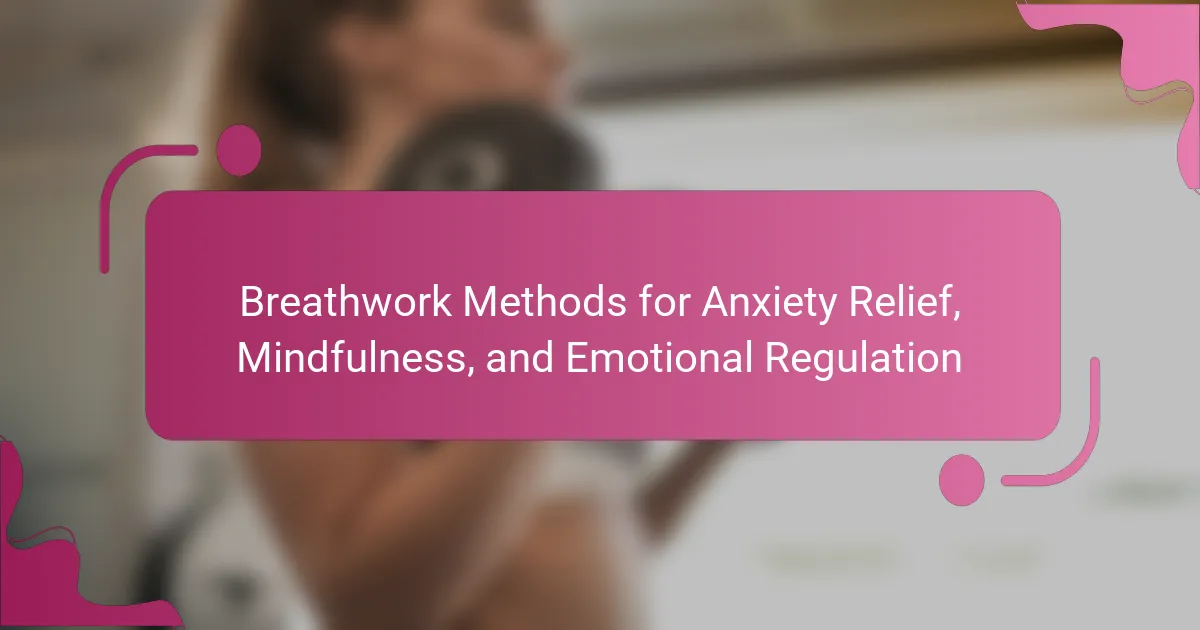Breathwork methods provide effective relief from anxiety and enhance emotional regulation. Techniques like diaphragmatic breathing and box breathing activate the parasympathetic nervous system. Mindfulness practices improve awareness and emotional processing. Cultural variations influence the effectiveness and acceptance of these methods, while consistent practice helps integrate breathwork into daily life.
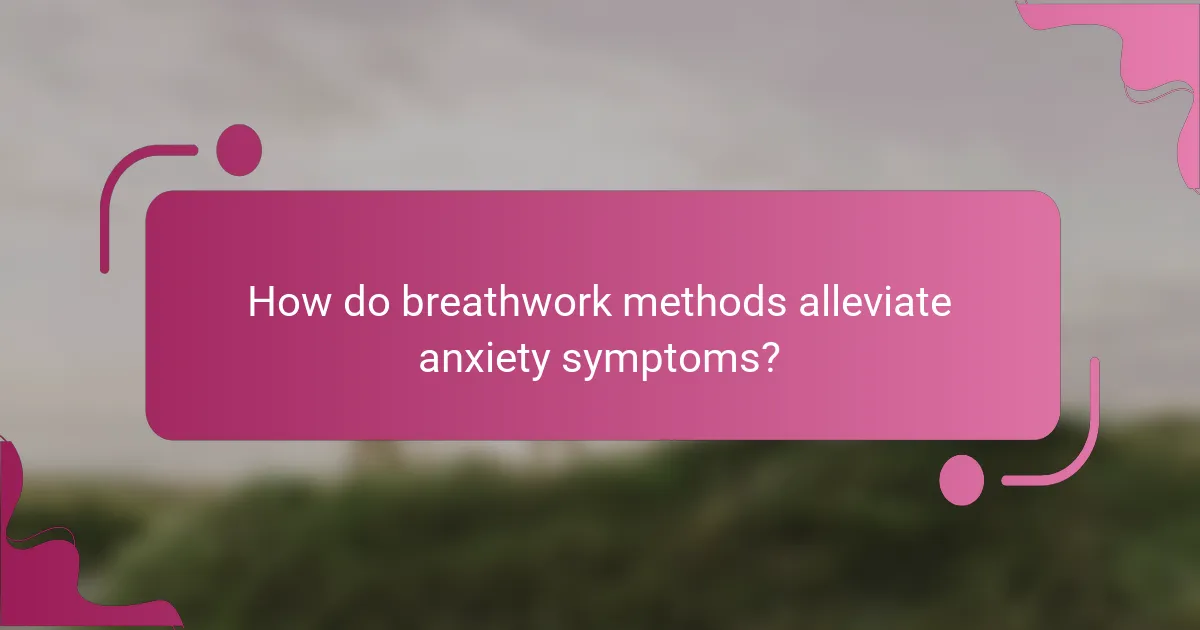
How do breathwork methods alleviate anxiety symptoms?
Breathwork methods significantly alleviate anxiety symptoms by promoting relaxation and emotional regulation. Techniques such as diaphragmatic breathing and box breathing activate the parasympathetic nervous system, reducing stress hormones. A study found that consistent breathwork practice can lower anxiety levels by up to 40%. Additionally, breathwork enhances mindfulness, allowing individuals to focus on the present moment, which further diminishes anxiety. Engaging in these techniques fosters a sense of control and empowerment, contributing to overall mental well-being.
What physiological changes occur during breathwork?
Breathwork induces several physiological changes that enhance emotional regulation and mindfulness. These include reduced heart rate, lower blood pressure, and increased oxygenation of the blood. As a result, individuals often experience decreased anxiety levels and improved mental clarity. Additionally, breathwork can stimulate the vagus nerve, promoting a relaxation response that counteracts stress. This method also enhances awareness of bodily sensations, leading to better emotional processing.
Which breathwork techniques are most effective for anxiety relief?
Breathwork techniques such as diaphragmatic breathing, box breathing, and 4-7-8 breathing are effective for anxiety relief. Diaphragmatic breathing lowers heart rate and promotes relaxation. Box breathing enhances focus and emotional regulation. The 4-7-8 method reduces stress and encourages a calm state. Each technique can be practiced easily and offers immediate benefits.
How does breathwork compare to traditional anxiety treatments?
Breathwork offers a holistic approach to anxiety relief, contrasting with traditional treatments like medication and therapy. Breathwork techniques, such as diaphragmatic breathing and box breathing, promote mindfulness and emotional regulation without side effects. Traditional treatments often rely on pharmaceuticals that can have varying efficacy and potential dependency issues.
Research indicates that breathwork can reduce anxiety levels significantly, with studies showing a 30% decrease in anxiety symptoms after consistent practice. In contrast, traditional treatments may take weeks to show effects. Breathwork also enhances self-awareness, allowing individuals to manage anxiety triggers effectively.
While traditional treatments are essential for some, breathwork provides a unique, accessible alternative. It can be practiced anywhere, making it a rare attribute that enhances its appeal. As a result, many individuals find it a valuable complement to conventional methods for comprehensive anxiety management.
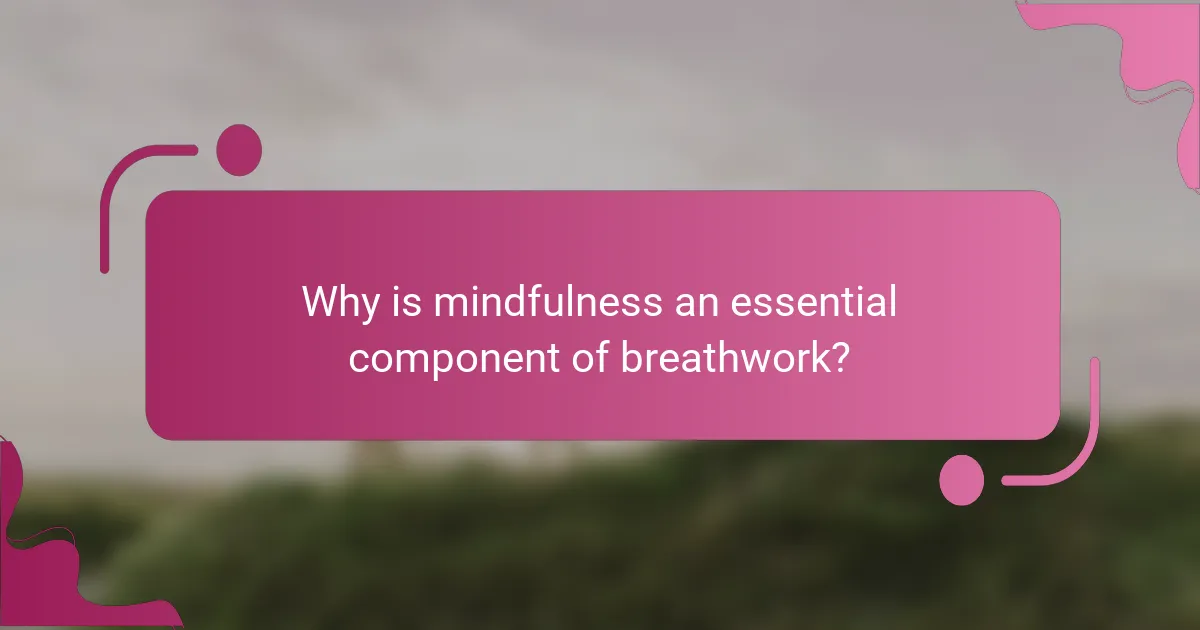
Why is mindfulness an essential component of breathwork?
Mindfulness is essential in breathwork because it enhances awareness and emotional regulation. Practicing mindfulness during breathwork allows individuals to focus on their breathing patterns, reducing anxiety and promoting relaxation. This heightened awareness helps in recognizing and processing emotions effectively. As a result, incorporating mindfulness into breathwork methods can lead to lasting improvements in mental well-being.
How can breathwork enhance mindfulness practices?
Breathwork enhances mindfulness practices by promoting relaxation and emotional regulation. Techniques such as diaphragmatic breathing and box breathing reduce anxiety, fostering a deeper connection to the present moment. These methods increase awareness of bodily sensations and thoughts, allowing for better emotional management. Regular practice can lead to improved mental clarity and focus, reinforcing mindfulness.
What role does breath awareness play in emotional regulation?
Breath awareness significantly enhances emotional regulation by promoting mindfulness and reducing anxiety. It helps individuals recognize emotional triggers and respond calmly. Focusing on breath encourages a state of relaxation, which can lower stress levels and improve emotional resilience. Research indicates that consistent breathwork practices can lead to better emotional control and overall mental well-being.
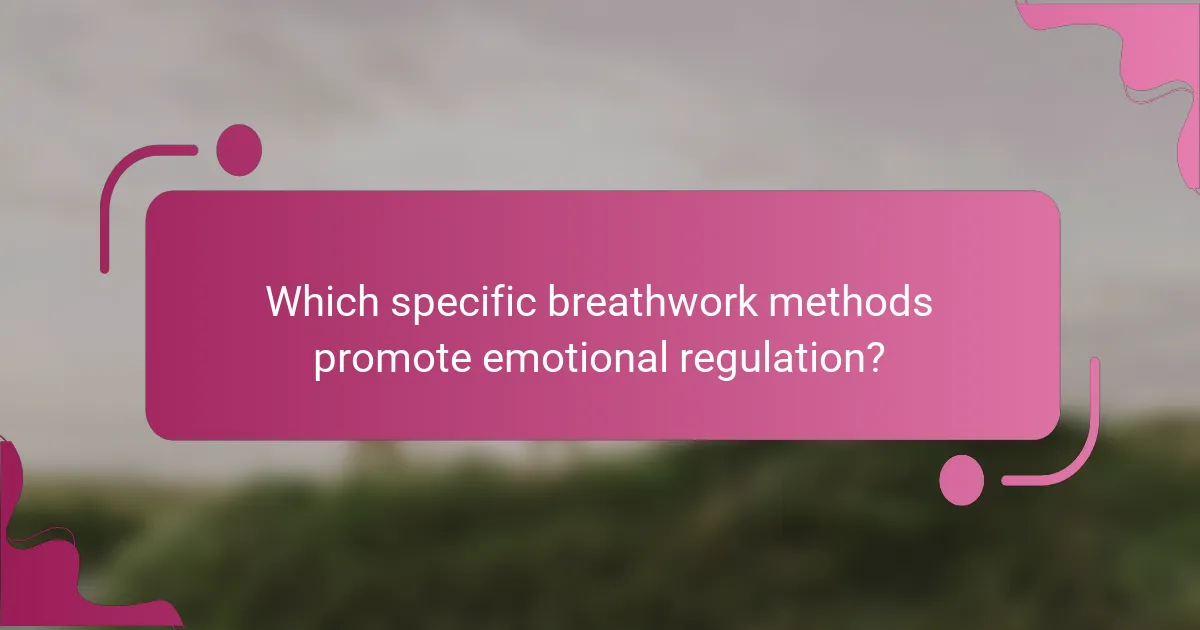
Which specific breathwork methods promote emotional regulation?
Breathwork methods such as diaphragmatic breathing, box breathing, and alternate nostril breathing effectively promote emotional regulation. Diaphragmatic breathing reduces stress by activating the parasympathetic nervous system. Box breathing enhances focus and calmness through structured inhalation and exhalation patterns. Alternate nostril breathing balances energy and emotions, fostering a sense of tranquility. Each method offers unique benefits, contributing to improved anxiety management and emotional stability.
How do different breath patterns influence emotional states?
Different breath patterns significantly influence emotional states by altering the autonomic nervous system. Slow, deep breathing promotes relaxation and reduces anxiety, while rapid, shallow breathing can increase stress and agitation. Breathwork methods, such as diaphragmatic breathing, enhance mindfulness and emotional regulation by fostering awareness of breath and body sensations. Techniques like box breathing create a sense of stability, helping to ground emotions and improve focus.
What are the unique benefits of guided breathwork sessions?
Guided breathwork sessions offer unique benefits such as enhanced emotional regulation, reduced anxiety, and improved mindfulness. These sessions create a supportive environment that fosters deeper relaxation and self-awareness. Participants often experience immediate stress relief and a greater sense of connection to their emotions, which aids in processing feelings effectively. Additionally, guided breathwork can lead to profound insights, promoting personal growth and resilience.

How can cultural variations influence breathwork practices?
Cultural variations significantly shape breathwork practices, influencing techniques and perceptions. Different cultures emphasize unique attributes in breathwork, such as the spiritual aspect in Eastern traditions versus the therapeutic focus in Western approaches.
For instance, in many Indigenous cultures, breath is seen as a life force, leading to practices that incorporate storytelling and communal experiences. In contrast, modern Western methods often prioritize individual mental health benefits, emphasizing structured techniques like diaphragmatic breathing.
Moreover, cultural beliefs about emotions and mental health can affect how breathwork is taught and received. In some cultures, expressing emotions openly is encouraged, while in others, restraint is valued. This variation can impact the effectiveness of breathwork for anxiety relief and emotional regulation.
As a result, understanding these cultural nuances is essential for practitioners to tailor breathwork methods to diverse populations, enhancing their effectiveness and acceptance.
Which regional breathwork traditions have gained global popularity?
Breathwork traditions from various regions have gained global popularity for their effectiveness in anxiety relief and emotional regulation. Techniques like Pranayama from India, Holotropic Breathwork from the U.S., and Transformational Breath from the U.K. are widely practiced. These methods emphasize mindfulness, helping individuals connect with their emotions and promote relaxation. Each tradition offers unique approaches, making them accessible to diverse audiences seeking mental wellness.
How do local beliefs shape the approach to breathwork?
Local beliefs significantly influence how breathwork is practiced for anxiety relief and emotional regulation. Cultural contexts shape the techniques and intentions behind breathwork sessions. For instance, some cultures emphasize communal practices, integrating social support into breathwork, while others focus on individual experiences. Additionally, local traditions may incorporate specific breath patterns or rituals that align with spiritual beliefs, enhancing mindfulness. The unique attributes of these practices can lead to varying outcomes in emotional regulation, reflecting the diverse ways communities perceive and utilize breathwork.
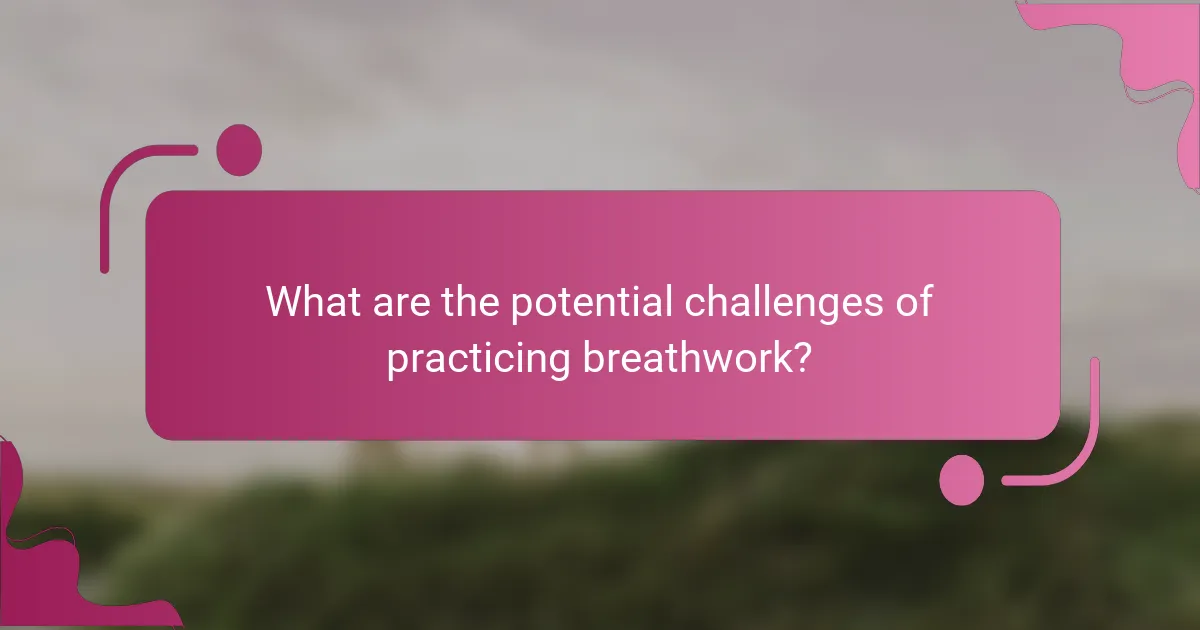
What are the potential challenges of practicing breathwork?
Practicing breathwork can present several challenges, including emotional release, physical discomfort, and varying effectiveness. Participants may experience intense emotions, which can be overwhelming. Physical discomfort may arise from prolonged positions or breathing techniques. Additionally, not all methods work equally for everyone, making it essential to find the right approach tailored to individual needs. Regular practice and guidance can help mitigate these challenges.
How can beginners overcome common obstacles in breathwork?
Beginners can overcome common obstacles in breathwork by practicing consistently, starting with simple techniques, and focusing on their breath without judgment. Establish a routine to build familiarity. Use guided sessions to ease anxiety and enhance mindfulness. Seek community support for motivation and accountability.
What precautions should be taken when practicing breathwork?
When practicing breathwork, it is essential to take precautions to ensure safety and effectiveness. Start in a comfortable environment and avoid doing breathwork while driving or operating machinery. It is advisable to consult a healthcare professional if you have pre-existing respiratory or cardiovascular conditions. Gradually increase the intensity and duration of sessions to prevent dizziness or hyperventilation. Stay hydrated and listen to your body, stopping if you feel uncomfortable.
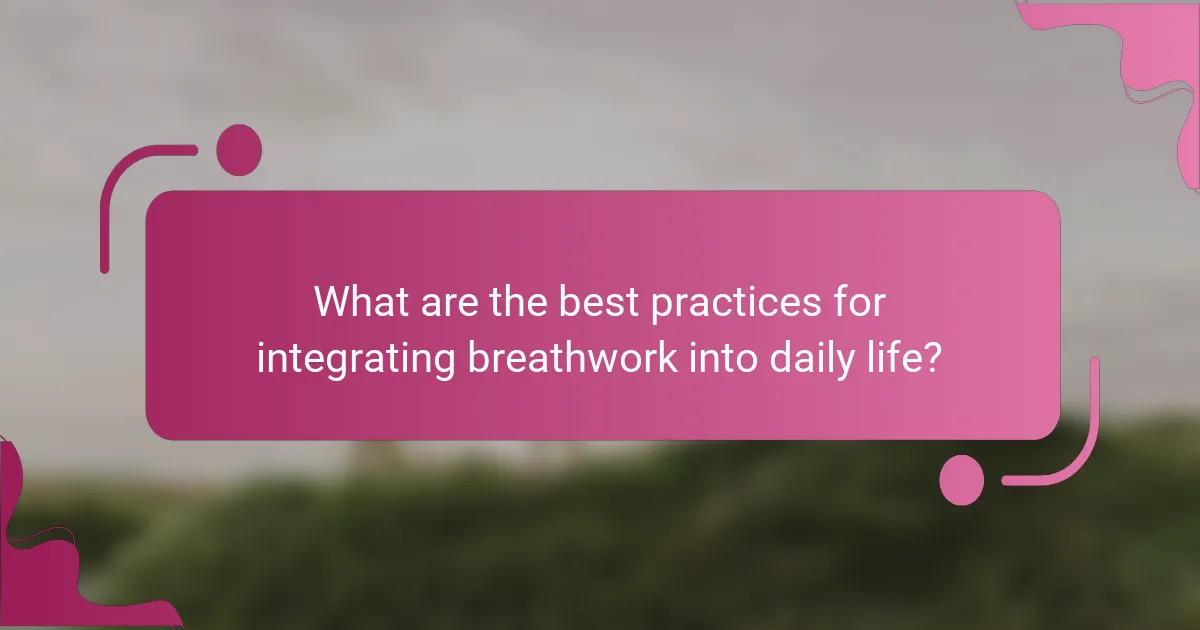
What are the best practices for integrating breathwork into daily life?
Integrating breathwork into daily life enhances anxiety relief, mindfulness, and emotional regulation. Start by setting aside dedicated time for practice, even if just a few minutes daily.
1. Establish a routine: Choose specific times for breathwork, such as morning or evening, to create consistency.
2. Use guided sessions: Leverage apps or online videos to follow structured breathwork techniques.
3. Incorporate mindfulness: Pair breathwork with meditation or yoga for holistic benefits.
4. Practice in various settings: Engage in breathwork during breaks at work or while commuting to reduce stress.
5. Track progress: Maintain a journal to reflect on emotional changes and improvements in anxiety levels.
These practices can help make breathwork an integral part of your lifestyle.
How can individuals create a personalized breathwork routine?
Individuals can create a personalized breathwork routine by identifying their specific needs and preferences. Start by selecting techniques that resonate, such as diaphragmatic breathing for anxiety relief or box breathing for mindfulness. Consider the duration and frequency of practice, aiming for consistency. Experiment with different environments to find one that enhances focus. Track progress and adjust the routine as needed to ensure it remains effective and enjoyable.
What expert tips can enhance the effectiveness of breathwork?
To enhance the effectiveness of breathwork, focus on consistent practice, intentional breathing techniques, and mindfulness integration. Establish a routine to build familiarity and comfort with various methods. Use techniques like diaphragmatic breathing to promote relaxation and emotional regulation. Incorporate mindfulness by paying attention to sensations and thoughts during breathwork. As a result, these practices can significantly reduce anxiety and improve overall well-being.
Which common mistakes should be avoided in breathwork practice?
Common mistakes to avoid in breathwork practice include improper technique, lack of focus, and ignoring personal limits. Practicing breathwork without guidance can lead to ineffective results or discomfort. Failing to create a conducive environment may hinder relaxation and mindfulness. Additionally, neglecting to set intentions can reduce the emotional regulation benefits of breathwork.
